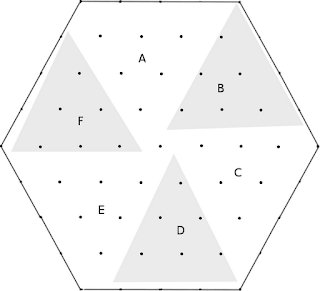This is related to the last couple of posts about the abstractness of wilderness travel in our game. It isn't a mini-game so-to-speak, but could work with the mini-game idea. Think of this as an attempt to help players and DM share a visualization of a hex of wilderness.
I ran into the problem of abstractness in my own game. The players had an idea of the direction an island was in. They headed that way. But the ocean hexes I'm using are
72 miles across. Do they encounter the island? Even with a visibility of miles, will they be close enough to see it? I have no idea and had no idea how to even begin adjudicating that. So I just said they found it.
Now I know one solution is to map my world down to the mile so I would know exactly where the island was. But, no, I have no intention on mapping a world to that degree when there is no guarantee players will ever venture there. But more importantly, even my knowing my world that intimately doesn't translate into my players being able to benefit from it. Players can't see your map, they don't necessarily see in their head what you see in your head when you say "swamp," and they certainly don't see the difference between swamp hex 1 and swamp hex 2. I suppose it's possible to describe in such detail- "This swamp hex is filled with purple flowers that start giving way to Spanish moss"-- and if you want to do that I have nothing against you. I just think there are probably easier, less work-intensive ways to achieve similarly blurry images of landscape in the minds of players.
So, one way is to use landmarks-- when they encounter the big cairn of bluish rocks, they'll know where they're at. I learned this from
ckutalik, he calls it a pointcrawl. I think it's cool and plan to try it. But you're still left with the empty abstract spaces between those landmarks,
especially in the ocean. So why not embrace that abstractness for the benefit of the players and the game?
How about something like the old Battleship game. Instead of hexes within hexes within hexes, you just have keyed abstract points that players can maneuver by. Something like this:
(The dots in each area should probably be numbered from 1-6 but I'm too wiped to do it right now.) The idea is that the party enters the hex from a particular point, let's say D6. Then, in searching for Animal Island they tell me where they head. Maybe they'll head to D3 towards the center of the hex. As long as I pick one of these locations for the island and have an idea of view distance it should work great.
I can decide on a certain number of dots moved depending on whether they are fighting the wind or not. And obviously the more they have to wander around the hex searching the more chances to encounter wandering monsters and interesting local encounters.
Keep in mind, this isn't a map, so players can still get lost. If the navigator fails a check or something maybe they think they are at D3 when they've actually drifted to C6.
It should be a snap to randomly place things: 1d6 for the area, 1d6 for the point in that area. With this image as a foundation and something you don't have to worry about, you can turn your attention to other things like view distance varying in different terrain types. Maybe in the forest the characters won't see the old Empire road until they walk onto a point that is on it. Then they can follow the road with its movement rate advantages. But maybe on prairie they can see a dwelling whole areas away and head for it or circle around it.
I know that you could do essentially the same thing if the dots were smaller hexes (and I'm betting some of you do), but in my mind a hex is still a boundary encompassing other things and my mind is constantly confused at what zoom level its at. With the dots I'm hoping to avoid that confusion for me
and the players.












